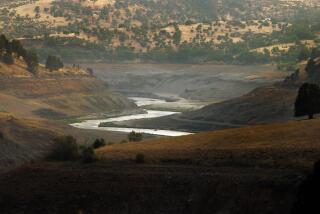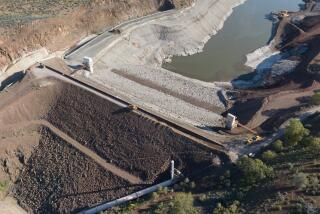Anti-Terror Closing Clogs Streets
- Share via
FOLSOM, Calif. — War can come home in many ways. For this bustling little city, it hits each morning and evening with a traffic jam.
Commuters used to avoid the narrow, Gold Rush-era streets of the city’s historic downtown by steering onto a two-lane shortcut atop Folsom Dam’s massive concrete cap. But a few weeks before the war in Iraq, federal officials shut down the dam’s old road, sending 18,000 extra motorists each day onto Folsom’s aging streets.
Gridlock has come because authorities fear a terrorist bomb could shatter the seemingly unassailable, 280-foot-high dam and send a torrent of water rushing toward Sacramento, 20 miles west. Within hours of such an event, officials warn, the Capitol dome could be surrounded by flood waters a dozen feet deep.
Such a nightmare scenario isn’t lost on Folsom’s residents. They’re not short on patriotism. And they’re not above compromise for the good of the country.
But from rankled motorists to buffeted civic leaders, they’re dismayed over a federal decision that many consider unjustified, even amid the realities of war and terrorism.
Mayor Steve Miklos is as peeved as the next person. He considers himself a guy happy to wave the flag. He’s behind the troops. But in the new national balancing act between fear and getting on with life, Miklos is having a hard time with the closing of the little road across the dam. It doesn’t help that he gets as many as 70 e-mails a day from irate motorists.
Miklos has more than a few beefs about the road’s closing, which began Feb. 28. No credible threat has been reported against the dam, he said. On the state’s list of potential terrorist targets, Folsom Dam ranks 63rd (Los Angeles International Airport is No. 1). Explosives experts tell him that even a huge blast couldn’t bring it down. Airspace over the dam remains open.
Meanwhile, even bigger structures with far more water behind them, such as towering Hoover Dam, haven’t been closed to traffic. In short, Miklos said, the decision “just doesn’t add up.”
Folsom’s streets ripple with tales of commuter chaos. Drive times doubled or tripled. Grocery trips avoided. Tempers flaring amid accidents. Pedestrians nearly smacked by irate motorists. Grumpy drivers rising before dawn to beat the new rush-hour crunch. Leafy old neighborhoods overrun with invading vehicles.
Emily Supanich said the congestion she now faces “is like a wall.” Friends one town away don’t bother visiting, and the charm of Old Town has been tarnished, she said, adding, “They’ve made our lives inaccessible.”
Tom Aiken feels her pain. Aiken is the man who runs Folsom Dam for the U.S. Bureau of Reclamation. Although his bosses in Washington made the decision to close Folsom Dam Road, he has been left to deal with the consequences. He professes sympathy for Folsom’s gridlocked masses. But he doesn’t see any way around the problem.
Among the dozens of dams operated by the federal government, Folsom’s isn’t the biggest and doesn’t impound the most water (its 975,000 acre-feet of storage is dwarfed by the 4 million acre-feet behind Shasta Dam). But more than any other, it looms large beside a vulnerable metropolitan area. More than 500,000 people and $40 billion in businesses, homes and infrastructure are at risk.
Federal officials never worried much about the road before Sept. 11, 2001. After the terrorist attacks, the U.S. Defense Threat Reduction Agency reviewed the vulnerability of dams, focusing on the towering “crown jewels” of the system -- Hoover, Glen Canyon, Grand Coulee and Shasta, the linchpin of California’s water system.
Folsom Dam bobbed to the surface as a crucial issue because its waters, if released, would threaten more people than any of the others, Aiken said.
Last summer, he said, a team of terrorism experts descended on the dam, poring over “every nut and bolt.” They identified several vulnerabilities, including the old road spanning the length of the concrete structure. A powerful bomb set off atop the dam, federal experts concluded, could unleash a catastrophe. “It was very clear,” Aiken said, “this was not something we could put off.”
The narrow asphalt strip on the dam originally was a simple maintenance road, but was opened to the public years ago so boat trailers and other recreational traffic could circumnavigate the lake. That perfunctory role expanded with Folsom’s growth.
Born a mining and railroad town but fixed on the national map when Johnny Cash sang of Folsom Prison, the city has seen a construction boom that brought an Intel Corp. plant, shopping centers and vast housing tracts. Folsom now has 60,000 people.
In recent years, commuters on both sides of the lake latched onto the dam road as a shortcut to avoid the historic downtown, where Wild West commercial buildings crowd narrow lanes ill-suited for heavy commuter traffic.
Old Town has been awash with cars ever since steel gates went up to block the dam road. Any workday afternoon, motorists back up across Rainbow Bridge. Hordes of drivers ignore electronic signboards advising the use of major streets, cutting instead into neighborhoods in a fruitless quest to escape.
John Reiner watched them snake past his tidy two-story clapboard one day recently. He could only shake his head. Traffic has tripled, sometimes roaring past at 40 mph on a residential lane meant for half that, the retired construction worker said. “I just tolerate it. It’s here. What are you going to do?”
Down the street, Vern Anderson, 79, recalled the old days, when the street saw “maybe five cars a day.” Now at “breakfast, lunch and go-home time,” he said, “it’s more like Highway 50.”
Even so, he’s not pushing for opening the dam road. A retired Air Force employee, Anderson has two American flag stickers affixed to his home’s front window. He favors caution over convenience in a time of war. But like almost everyone else in Folsom, he would like relief.
It could come with a proposed new bridge a quarter-mile downstream from the dam. Two local congressmen are pushing bills to fund the $66-million solution. City officials say Folsom is owed. When Congress authorized the dam in the late 1940s, federal officials promised to replace four roads flooded by Folsom Reservoir. None have been built.
Even if funding arrives, design and construction could take five years. City officials are pushing for quicker relief. Miklos traveled to Washington in early March, pressing officials in the Bureau of Reclamation for a reprieve. He’ll go again next week.
In advance of the trip, the City Council dispatched a letter to Washington, asking that the road be reopened during commuter hours, but remain off-limits to big trucks.
The council also proposed a menu of security improvements, from increased video surveillance to random vehicle searches. Finally, it asked federal officials to cut a check to offset $30,000 the city spent to manage the increased congestion.
In the meantime, commuters have been left to stew.
Jeri Lou Paul saw her morning drive time double. She’s riding her bike now, and the seven-mile trip is as fast on two wheels as four, she said.
“They put a couple of National Guardsmen out on the Golden Gate Bridge to protect it, but they completely shut down the road on Folsom Dam,” she said. “It doesn’t make sense.”
Business has ebbed along clogged corridors, which some merchants say is the result of customers’ being scared off by traffic.
“They’re frustrated,” Andi Adkins-Pogue said at her custom picture framing shop beside Folsom’s most traffic-choked intersection. “Running a quick errand can take 20 minutes.”
But many folks choose to tolerate it. Suzanne Fisher battles the congestion like everyone else. But we’re in a changed world, she said. There’s a war on, and bigger worries.
Fisher has a nephew, 19, in Iraq. He’s a gunner on a Humvee. She can’t hold back the tears just thinking about him.
“Because of my nephew, I look at this whole traffic mess and say it’s not that big a deal,” Fisher said. “That’s the reality. We’re all in a war zone. So you’re five minutes late. So what? Let it go.”
More to Read
Sign up for Essential California
The most important California stories and recommendations in your inbox every morning.
You may occasionally receive promotional content from the Los Angeles Times.













